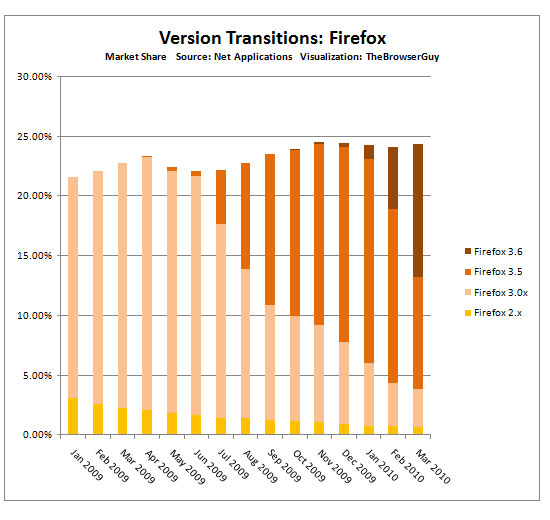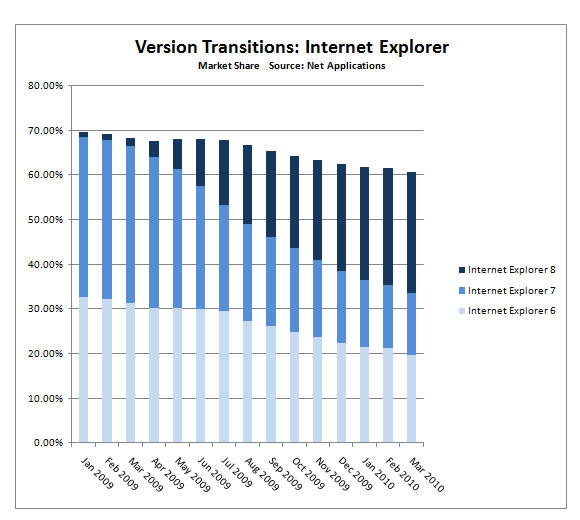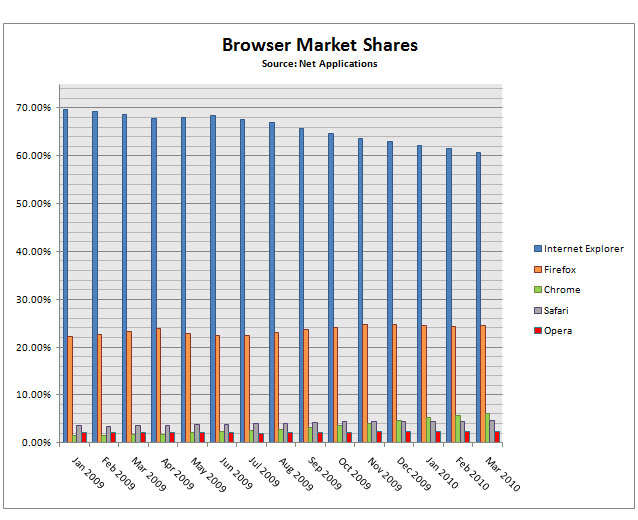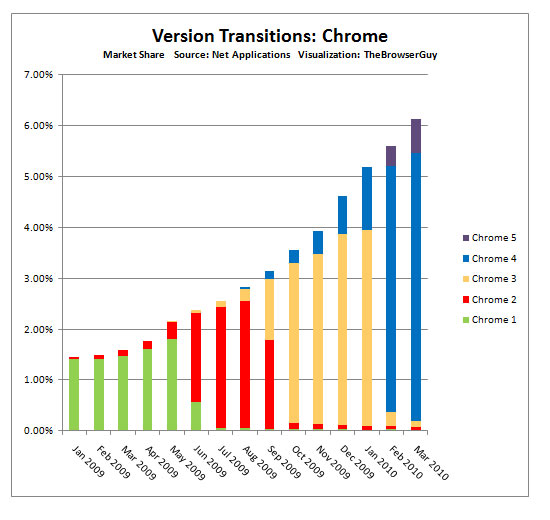Why Mozilla Needs To Go Into Survival Mode
The writing is on the wall. While Mozilla and its Firefox browser appear to be a very solid institution in the browser market, it is the weakest link with an extremely attractive portion of the browser user base as well. Google is getting more serious about the browser market and Microsoft is apparently getting back into the game as well.
Could Mozilla be squeezed out of the market?
Today, there is very little that could lead you to believe that Mozilla and its Firefox browser area are under competitive pressure. In the end, isn’t it Firefox that continues to challenge Microsoft’s Internet Explorer (IE) and is responsible that IE dropped from more than 90% market share closer to about 60% today, according to Net Applications? Mozilla itself recently noted in its Metrics report that its market share hovers “near 30%”. If we believe this global number, then North America’s has the lowest share of about 26% and Europe the highest with about 39%.
The Numbers
Mozilla calculated the numbers by averaging different estimates from Net Applications, Quantcast, NetApplications and Gemius. There is only public access to detailed browser usage data at NetApplications, which can provide some insight in browser usage trends, while the actual market share estimate varies enough to make you question the accuracy of any of these reports.
NetApplications for example, believes that the market share of Firefox is in the neighborhood of 24%, while Gemius puts it closer to 46%, StatCounter at 32%, and Quantcast at 36%. Interestingly, Mozilla itself says that NetApplications claims a 35% market share for Firefox, which this is not what NetApplications publicly states (about 24%). Obviously, the actual market share is almost impossible to pin down as you can spin the number in any direction you want by using the statistics that suit your purpose best.
What is much more interesting are browser usage trends. So let’s look at what has happening with Firefox. StatCounter indicates that Firefox’ share climbed from 29.4% in March 2009 to 31.93% in April 2010, a gain of roughly 1.8 points or 6%. There is a relatively consistent slight upward trend that seems to be turning into a very stable market share of just above 30%. Microsoft’s IE is losing dramatically, from 62.52% to 53.12% over the past 12 months, while Apple’s Safari is showing slight gains and a market share of about 4%, Opera being stable and Chrome revealing the strongest gains, from 1.73% in March 2009 to 8.03% in April 2010. According to StatCounter, Chrome is showing the strongest gains in percentages (564%) and absolute numbers (6.3 points).
Get Tom's Hardware's best news and in-depth reviews, straight to your inbox.
NetApplications data shows a similar shows trend: IE down, Firefox stable to up, Opera stable, Safari stable to up, Chrome up. The company estimates IE’s share at 60.64% (down from 68.84% in March 2009), Firefox at 24.52% (up from 23.30%), Chrome at 6.13% (up from 1.62%), Safari at 4.66% (up from 3.62%) and Opera stable at 2.37% (2.12%). Conceivably, the only dynamic parts in the current market are Internet Explorer and Chrome. IE lost 8.2 points of market share or 11.9% in twelve months, while Chrome gained 4.51 points or 478%.
As far as NetApplications’ data reveal, Mozilla saw Firefox market share decline in five of the past 12 months, with drops as sharp as 0.32 points in June 2009. Chrome, on the other side, had only positive growth with gains of as much as 0.59 points in January 2010. In fact, the absolute gains seem to be accelerating lately and Google was able to maintain a percentage growth in the high single digits or even double digits (in seven of the past 12 months). Even if Chrome’s market share is growing and common sense suggests that the percentage growth should be slowing, Chrome is getting stronger every month, if we believe NetApplications’ data set. It already chewed up Apple’s Safari, which it surpassed in market share in December 2009 and now has a lead of already 1.47 points.
Upgrades
Clearly, Google got something right and its strategy is working. One part of the strategy certainly is the availability of plug-ins, but it is more and more apparent that Google’s consistent performance improvements (Google 5 Beta is the fastest browser you can get at this time) and aggressive upgrade cycle attract much more usage share.
Google 5 beta currently has a market share of 0.66% and is Chrome’s fifth browser version in the market over the past 12 months. Since March 2009, Google has successfully phased out Chrome 1, 2 and 3 and transitioned to 2, 3 and 4. The forced upgrade in Chrome ensures the most complete version transition we see in the browser market today: Chrome 4 has a market share of 5.26%, compared to Google’s entire 6.13% - and remember, the transition to version 5 has already begun. Version 3 has only 0.13% and 2 only 0.05%.
IE, in comparison, shows a different picture that is causing lots of headaches for Microsoft: IE6 is stuck in corporate standards and still has 19.71% market share, IE7 has 13.78% and IE8 27.13%. IE8, as a reminder, was fully launched into the market in March 2009 – which was the first month of significant market share gains for the browser. The differences to Google’s approach can’t be any more different.
Mozilla is somewhere between Microsoft and Google. Version 3.6 has become the dominant Firefox version with a share of 11.63%, followed by 3.5 with 9.39%, 3.0 with 3.21% and 2 with 0.64%. Both IE and Firefox are much more fragmented than Chrome. Chrome’s forced upgrade ensures you always have the latest version on your PC and, whether you like it or not, the strategy seems to be resonating with users.
What about Performance?
IE’s downside has been a lack of performance. IE9, however, which is currently only available as a rough Platform Preview, shows dramatic speed improvements that are currently just above the Javascript performance of Firefox 3.6 and Microsoft claims that it hasn’t even tuned the IE9 engine yet. Firefox 3.7 shows performance improvements as well, but it is too early to say who will keep the lead – especially since IE9 is at least 6 to 9 months away from a public release.
Chrome 5, however, crushes any other browser in any popular benchmark available on the web. On my quad-core test system, In Google V8, Chrome 5.0.342.8 scored 4456 points, which compares to 3804 of Chrome 4 and 654 of IE9 PP. In SunSpider, Chrome 5 is the first browser to break the 400ms barrier with 387.8ms, compared to 783.6ms of IE9 PP. In Celtic Kane, Chrome 5 came in at 503 points vs. 263 of IE9 PP. Firefox 3.6 currently scores 460 in Google V8, 890ms in SunSpider, and 160 in Celtic Kane.
Conclusion
Individual statistics may be skewed, but the overall trend seems to be obvious. Firefox just isn’t growing as much anymore as it has in 2007 or 2008. It would be foolish to ignore that Microsoft is making IE9 dramatically better (and it seems Microsoft is dropping proprietary web technologies as well) and that Google has a serious interest in the browser market. The investments Google is allocating to Chrome are apparent.
Google’s do not evil mantra seems out of place here. Chrome is part of the corporate strategy and if Mozilla is standing in the way, despite an ongoing friendly agreement that Google is funding Mozilla through royalties, then it will be sacrificed. It is believed that Google’s royalties account for about 80-90% of Mozilla’s entire revenues. The royalty contract will end in 2011.
At the very best, Mozilla has an ongoing financing problem by being too dependent on Google, which has now an interest in the very market that is Mozilla’s beating heart. I’ll leave it up to you to predict what will happen in this space, but it is clear that Chrome is gaining market share at a fast pace and Microsoft will do everything it can to stop the bleeding as it needs IE9 as a central part for its cloud computing strategy. At the current pace, Google may catch up with Firefox’ market share within two to three years – and that is if Microsoft simply stands still. Add Microsoft to the equation and it becomes clear that you end up with a battle of the giants that leaves Mozilla in the middle of the battlefield, with a share of the market both Google and Microsoft want.
Mozilla needs to draw from the best it has to be able to survive this battle. And if it can, we should see amazing innovation in the browser field over the next five years.
Want to learn more about what's happening in this landscape? Join Wolfgang for a one hour Q&A session today at 5PM PST. Here's how to join.
Wolfgang Gruener is a technology journalist and analyst. He was managing editor for the Tom’s Hardware news section from 2003 to 2005, before launching and acquiring TG Daily. Today, Wolfgang works with startups and publishes his thoughts and analysis on critical and emerging technologies and products at Conceivablytech.com.

Wolfgang Gruener is an experienced professional in digital strategy and content, specializing in web strategy, content architecture, user experience, and applying AI in content operations within the insurtech industry. His previous roles include Director, Digital Strategy and Content Experience at American Eagle, Managing Editor at TG Daily, and contributing to publications like Tom's Guide and Tom's Hardware.
-
figgus IE, in comparison, shows a different picture that is causing lots of headaches for Microsoft: IE6 is stuck in corporate standardsReply
Good. It serves Microsoft right for trying to foist their own standards off as standards instead of being W3C compliant. I'm glad they are going to feel some pain over it. -
theholylancer as long as customize google (remove ALL google ads, even in gmail, and forces SSH for gmail and other apps), adblock (removes the rest) and noscript exists for fire fox and not chrome or IE, firefox is here to stay for those that wants the cheap web experience with nothing to do with any advertisements.Reply -
kelemvor4 The reason for the disparate numbers in EU for ie is that the EU forced MS to give users a choice in browsers up front rather than just delivering IE with each copy of windows. Hopefully someday the DOJ will follow suit.Reply
As for chrome, I'd be willing to give it a try if I could find an addon similar to adblock+. I've looked and found nothing, and until I get one; chrome is off the table for me. -
huron I just want to make sure I get this right...Reply
Since Firefox isn't growing as much as it has been, it's in survival mode? Yes, I realize the point about revenues from Google, and that ending in 2011, but it feels like most of the article talked about statistics that it claimed can be skewed, then concluded this meant Firefox was dying.
I would hate to see Firefox go away and hope they fight this slow-down in growth, but it feels like the argument is a bit out there. -
-Fran- Give the ballot screen some time to show it's fruition. Although the ballot screen might come as a "free competition break" in the EU, it's making the customers try other options (safari, opera, chrome, firefox) right off the bat without having to inform themselves through other sources. The ballot screen is a great idea (yes, as in "for all OSes") and should be forced/introduced as an OS standard with a comprehensive data about browsers to give customers the right of information about their choice.Reply
Cheers! -
jacobdrj figgusIE, in comparison, shows a different picture that is causing lots of headaches for Microsoft: IE6 is stuck in corporate standardsGood. It serves Microsoft right for trying to foist their own standards off as standards instead of being W3C compliant. I'm glad they are going to feel some pain over it.However, WE are the ones suffering for it. More viruses, worse compatibility. It isn't about 'serving them right', It is about us being able to use the internet productively.Reply
As an aside, I have switched my main mobile computing to a netbook from a tablet. Because of the slow hard drive, I have decided to do the bulk of my regular browsing in Chrome. However, if I ever stray into abnormal search/research or I go to a link I am unfarmiliar with, I fire up Firefox with all the regular security add ons. HOWEVER, the main reason I shifted away from Firefox, even on my Quad-Core Raptor-RAIDed desktop is the fact that Firefox, with the 3.5 release, had become VERY unstable. My FF would crash/freeze regularly, and I could no longer rely on it for mission critical stuff.





